Interim Data Targeting CD117 Show Promising MRD Results and Safety in MDS/AML
JSP191 combined with fludarabine, and low-dose total body radiation demonstrated facilitation of full donor myeloid chimerism, clearing of minimal residual disease, and a well-tolerated safety profile in older patients with myelodysplastic syndrome/acute myeloid leukemia receiving non-myeloablative allogenic hematopoietic cell transplantation.
Lori Muffly, MD, MS,

Early outcomes with the combination of JSP191, fludarabine, and low-dose total body radiation (TBI) demonstrated facilitation of full donor myeloid chimerism, clearing of minimal residual disease (MRD), and a well-tolerated safety profile in older patients with myelodysplastic syndrome/acute myeloid leukemia (MDS/AML) receiving non-myeloablative (NMA) allogenic hematopoietic cell transplantation (AHCT).
Results from the phase 1 trial (NCT04429191) presented at the 2022 Transplantation & Cellular Therapy Meetings, showed there were no infusion toxicities or serious adverse events with JSP191, and no instances of primary graft failure in first 24 patients enrolled on the trial; only 1 patient had secondary graft failure and went on to have successful retransplant. Additionally, MRD clearance was observed in 12 patients, and JSP191 pharmacokinetics were shown to be predictable.
AHCT is the only curative treatment for many patients with MDS/AML, even though there have been advancements in therapy for these patients in recent years. “While transplant has proven feasible for adults well into their 70s, the optimal conditioning regimen for older adults remains unknown as more intensive regimens tend to be associated with transplant-related mortality, while less intensive nonmyeloablative regimens have resulted historically in higher rates of disease relapse and progression,” Lori Muffly, MD, MS, said in her presentation.
“Therefore, a conditioning regimen that results in minimal toxicity but has enhanced disease control is needed in order to improve transplantation outcomes in this population,” Muffly, associate professor of medicine (blood and marrow transplantation and cellular therapy) at Stanford Healthcare, continued.
JSP191 is a humanized monoclonal antibody meant to block stem cell factor binding site on CD117, which is necessary for hematopoietic stem cell (HSC) survival and HSC interactions in the bone marrow niche. After the bone marrow niche is emptied because of JSP191 binding to CD117, healthy donor cells are able to engraft. Preclinical models showed synergy between anti-CD117 monoclonal antibodies and low-dose TBI to help deplete HSC and facilitate donor cell engraftment.
For the first 24 patients with MDS (n = 13) or AML (n = 11), primary end points evaluated were safety, tolerability, and pharmacokinetics of the combination. Secondary end points included engraftment and donor chimerism, MRD clearance, relapse-free survival, graft-vs-host disease (GVHD), non-relapse mortality, and overall survival. Patients received AHCT, then 200 to 300 cGy of TBI, 30 mg/m2 of fludarabine for 3 days, and 0.6 mg/kg of intravenous JSP191.
To determine the starting date of fludarabine, real-time pharmacokinetic measurements and modeling were used after JSP191 was administered. For the first 7 patients, TBI was increased from 200 to 300 cGy to aid lymphoablation. Tacrolimus, sirolimus, and mycohphenolate motefil were used as GVHD prophylaxis.
Consistent pharmacokinetics and predictable clearance were observed with JSP191 over the 2 weeks after administration. “All patients were able to receive donor cell infusion between 9 and 15 days following administration of the antibody. Interestingly, we did see in some patients very low levels of the antibody present on the day of donor cell infusion, and this did not appear to impact donor cell engraftment,” Muffly said.
Bone marrow aspirations taken at screening and between administration of the antibody and fludarabine/TBI showed JSP191 depletes hemopoietic stem and progenitor cells (HSPC). In the CD34-positive, CD45RA-negative population, there was a 66% mean depletion of HSPC. The investigators do not believe this reflects the nadir of HSPC depletion, Muffly explained, and that the depletion continues until donor stem cell infusion.
All patients experienced neutropenia followed by neutrophil engraftment between TD+15 and TD+26. Primary engraftment was seen in all patients, with only 1 patient losing myeloid chimerism early, which was associated with disease progression. T cell chimerism improved when patients went up from 200 to 300 cGy.
Using flow cytometry, cytogenetics, and next-generation sequencing, investigators were able to track MRD in patients with de novo AML (n = 8) and AML from MDS (n = 3). Of the 9 patients with AML who were MRD positive at the time of enrollment, 6 were MRD negative at the time of follow-up. Eleven of 13 patients with MDS were MRD positive at enrollment, and 8 were MRD negative at the last follow-up.
After 6 months median follow-up (range, 2-12 months), there were no reports of classical grade II-IV acute GVHD. One case of late onset grade III-IV acute gastrointestinal GVHD was reported as of the latest follow-up, but this patient had non-relapse mortality. Any instances of chronic GVHD has yet to be reported due to insufficient median follow-up time. Morphologic relapse occurred in 4 patients, 3 with AML and 1 with MDS.
The median age for these patients was 70 years (range, 62-79), with a requirement of 60 years of age or older or an AHCT-comorbidity index of 3 or more to enroll in the trial. They could not have prior AHCT and needed a human leukocyte antigen–matched related or unrelated donor. Over half of patients received only a hypomethylating agent-containing regimens.
“JSP191 in combination with fludarabine and low-dose TBI is a novel conditioning platform that appears safe, well tolerated, has demonstrated on-target effects of HSPC depletion, permits full donor myeloid chimerism, and results in promising early MRD clearance,” Muffly concluded.
Reference:
Muffly L, Lee CJ, Gandhi A, et al. Preliminary data from a phase 1 study of JSP191, an anti-CD117 monoclonal antibody, in combination with low dose irradiation and fludarabine conditioning is well-tolerated, facilitates chimerism and clearance of minimal residual disease in older adults with MDS/AML undergoing allogeneic HCT. Presented at: 2022 Transplantation & Cellular Therapy Meetings; Salt Lake City, UT; April 23-26, 2022. Abstract LBA4. https://bit.ly/3xRTwee











